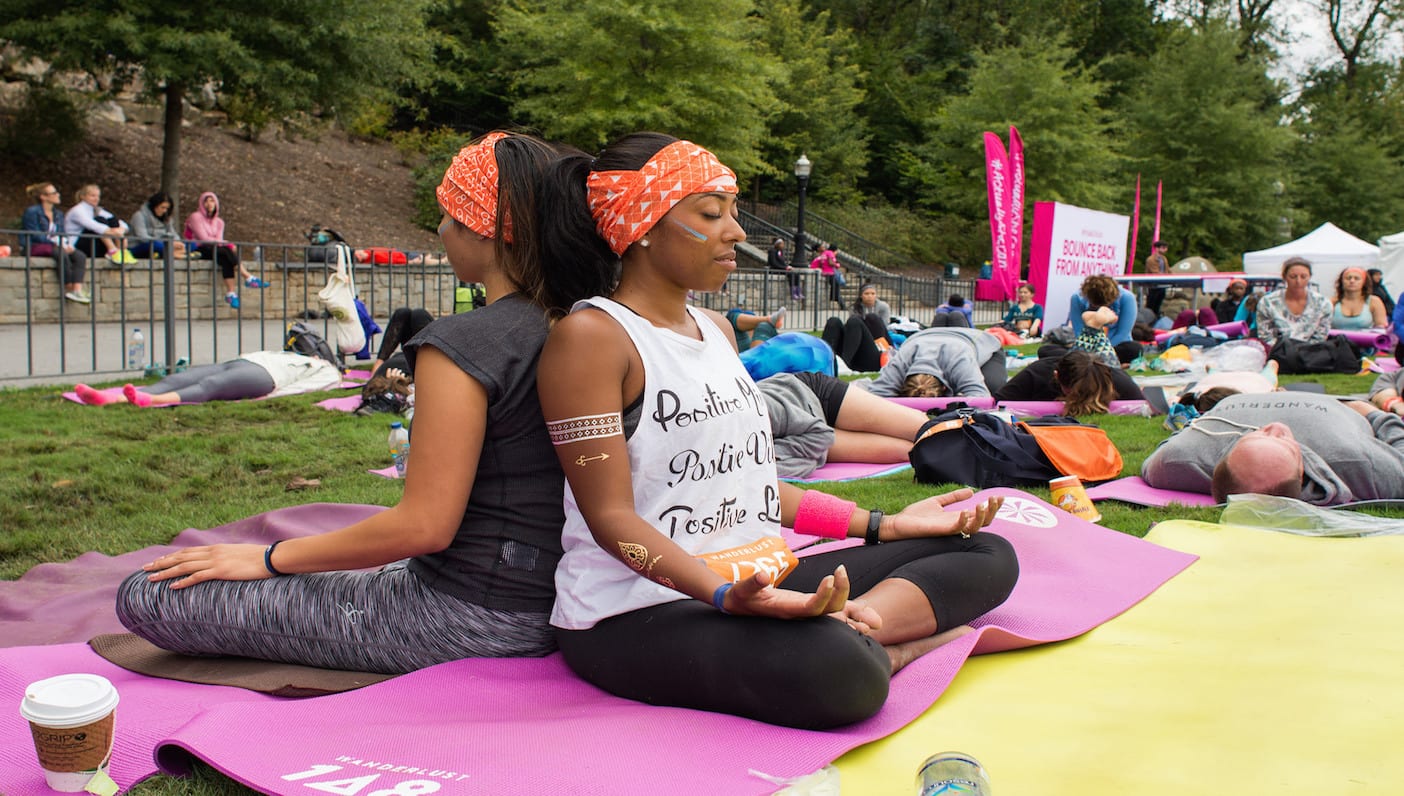
While not everyone may agree that separate yoga classes for people of color equates to progress, there is an increasing demand for these safe, separate spaces to cultivate non-discrimination.
In Brooklyn, experienced POC yoga teacher Calia Marshall leads an ongoing, once monthly “Brown Sugar: Yoga for Folks of Color” community-oriented class, to celebrate diversity free of judgement. With the stereotype of the thin white woman still dominating the yoga-sphere, Marshall aims to cultivate a sacred space for women of color to practice freely. And she’s not alone—Lauren Ash runs a studio called Black Girl In Om out of Chicago, and earlier this year, the recent Yoga Journal cover model Chelsea Jackson Roberts founded Red Clay Yoga, a non-profit catered toward educating and training marginalized communities to empower young women of color.
In a recent interview with Elle Magazine, these three teachers shared their views:
Both Ash and Roberts explained that the racial dynamics of their respective cities influenced their decision to found yoga classes for people of color. “Atlanta, in particular… has had a very deeply ingrained culture of separation, racially and socio-economically,” Roberts says. Roberts also hosts the Yoga, Literature and Art Camp for teen girls aged 13 to 17, who Roberts describes as “primarily black and Latina girls.” At one point, the students were creating vision boards, and they kept making comments about not seeing images in yoga of women who look like them. Ash shares similar sentiments: “Chicago is incredibly diverse, but it is really segregated. So, to be able to really allow for a space where you can connect with other people about wellness … while you might be experiencing microaggressions, or racism, or any form of discrimination, it’s just a really powerful thing,” she said.
Marshall has a similar impetus. “Violence that’s happening in our country has always been there,” she says when asked whether the current social climate–racially charged police brutality, increased media coverage of cultural appropriation, an incessant stream of identity-politics online arguments–had anything to do with the founding of Brown Sugar. “I think that the time is right for really putting voice to the injustice happening in the world.” There are ways of doing this, she says, that are “active” and then there are “quieter ways”: “If we’re just going to be out there screaming, yelling, and saying ‘You’re so messed up world,’ we become burned out. We need to find spaces where we rejuvenate…and have that energy to work together to fight the injustices of the world.”
But for some critics, separation may seem like a step backward when not handled with kid gloves. While the term “Person of Color” is arguably still politically correct for any non-white person, separating people of color in yoga classrooms is seen by some as a form of reverse discrimination. In Seattle, a yoga studio was criticized for offering a POC yoga class that excluded white students.
MyNorthwest.com has more:
Rainier Beach Yoga offered a monthly class called “Yoga for People of Color,” which was aimed at “people of color, and of all sexualities, ages, body sizes, abilities, genders, and experience with yoga,” but asked that “white friends, allies and partners” not attend. The class was met with controversy after KIRO Radio’s Dori Monson broke the story following a news tip from a listener.
Laura Humpf, the owner of Rainier Beach Yoga posted an apology on her website, saying she “never intended to exclude anyone based on race or ethnicity.” The message said the intention of offering her space to “POC Yoga” was to offer “a widely inclusive healing space where all people could receive the benefits of yoga.”
Teresa Wang, co-founder of the specialized class, said the class was started by five queer people of color who came together to create a safe space for people of color who might otherwise be uncomfortable.
One day, maybe all races, faces, genders, sizes and body types everywhere can feel at home in any yoga studio. But while the truth may be that we’re not quite there yet, we can applaud anyone who works tirelessly to provide people of color with a sacred space to practice.
Photo by Joyelan
–
 Andrea Rice is the Practice and Community Editor for Wanderlust Media. She is also a writer and yoga teacher. Her work has appeared in The New York Times, Yoga Journal, mindbodygreen, Yoganonymous, AstroStyle, and several music magazines. Her teaching style is a blend of her love for music and intuitive movement, with emphasis on core strength. You can find her regular classes at Shambhala Yoga in Brooklyn and connect with her on Instagram and Twitter.
Andrea Rice is the Practice and Community Editor for Wanderlust Media. She is also a writer and yoga teacher. Her work has appeared in The New York Times, Yoga Journal, mindbodygreen, Yoganonymous, AstroStyle, and several music magazines. Her teaching style is a blend of her love for music and intuitive movement, with emphasis on core strength. You can find her regular classes at Shambhala Yoga in Brooklyn and connect with her on Instagram and Twitter.
